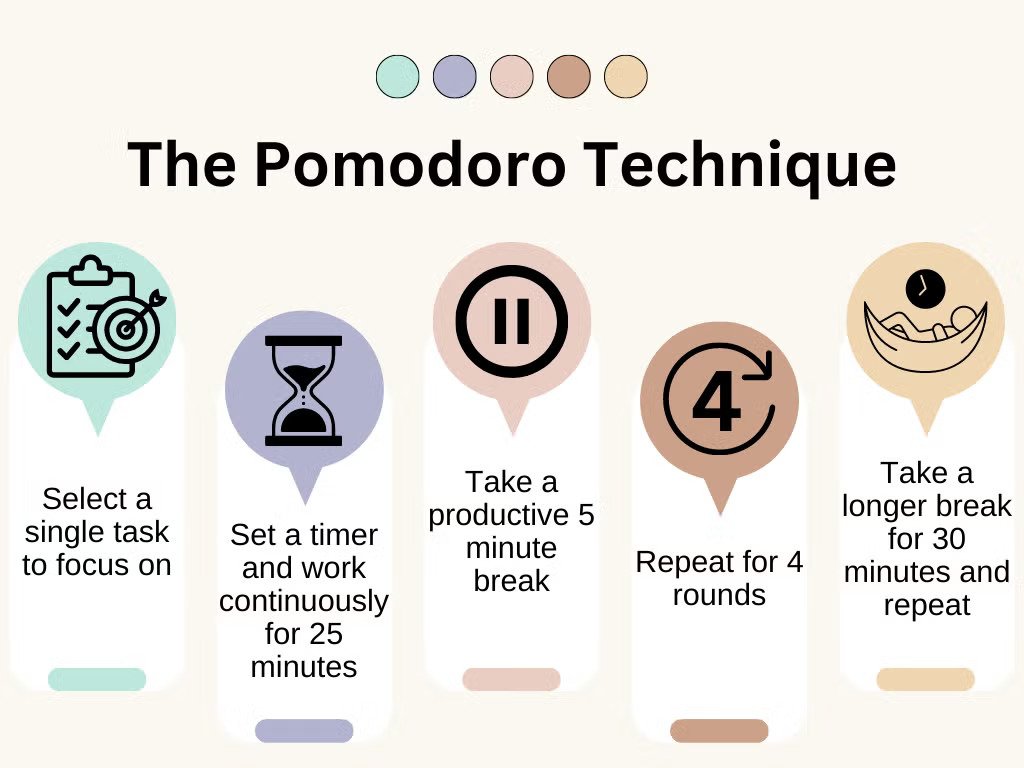
The Pomodoro Technique and ADHD: A Match Made in Heaven?
The Pomodoro Technique, a time management method involving 25-minute work intervals followed by short breaks, has gained popularity among individuals seeking to improve focus and productivity. But can this structured approach truly benefit those with ADHD, a neurodevelopmental condition characterized by inattention, hyperactivity, and impulsivity?
This blog post will delve into the potential of the Pomodoro Technique for individuals with ADHD, exploring its potential benefits, limitations, and how to adapt it for optimal success.
Understanding the Challenges of ADHD and Productivity

Individuals with ADHD often face significant challenges when it comes to productivity.
- Distractibility: The constant bombardment of internal and external stimuli can easily derail focus, making it difficult to complete tasks.
- Procrastination: The fear of failure, perfectionism, and the overwhelming nature of tasks can lead to significant delays and avoidance.
- Time Blindness: Difficulty with time perception can make it challenging to estimate how long tasks will take, leading to poor planning and missed deadlines.
- Hyperfocus: While seemingly beneficial, hyperfocus can also be detrimental, as it can lead to excessive time spent on one task while neglecting others.
The Pomodoro Technique: A Potential Solution?

The core principle of the Pomodoro Technique is simple:
- Set a timer for 25 minutes.
- Work on a single task without interruption for the duration of the timer.
- Take a 5-minute break.
- Repeat steps 1-3 four times.
- Take a longer break (15-30 minutes).
This structured approach can offer several potential benefits for individuals with ADHD:
- Improved Focus: By breaking down tasks into smaller, more manageable chunks, the Pomodoro Technique can help to reduce feelings of overwhelm and improve focus.
- Increased Motivation: The short work intervals can provide a sense of accomplishment and motivation to continue working.
- Reduced Procrastination: The structured nature of the technique can provide a framework for starting and completing tasks, making it less likely that individuals will procrastinate.
- Enhanced Time Management: By tracking time spent on tasks, individuals can gain a better understanding of their work habits and identify areas for improvement.
Adapting the Pomodoro Technique for ADHD
While the standard Pomodoro Technique can be beneficial, it may require some adjustments for individuals with ADHD:
- Adjusting Work Intervals:
- Some individuals with ADHD may find that 25-minute intervals are too long, while others may find them too short.
- Experiment with different interval lengths (e.g., 15 minutes, 20 minutes) to find what works best.
- Shortening Breaks:
- If frequent distractions are a significant issue, consider shortening the 5-minute breaks to 3 or 4 minutes.
- Visual Timers:
- Using a visual timer (e.g., a sand timer, a timer app with a visual countdown) can make the passage of time more concrete and help to maintain focus.
- Minimizing Distractions:
- Create a distraction-free environment by turning off notifications, silencing your phone, and finding a quiet workspace.
- Reward Yourself:
- Incorporate small rewards into your breaks to provide additional motivation and reinforce positive behavior.
Tools and Resources
Numerous tools and resources are available to help you implement the Pomodoro Technique:
- Timer Apps:
- Focus To-Do: A popular app that combines to-do lists with the Pomodoro Technique.
- Forest: An app that encourages focus by “planting” virtual trees that die if you leave the app.
- TomatoTimer: A simple and user-friendly timer app.
- Online Resources:
- Pomodoro Technique Website: The official website provides a wealth of information and resources.
- ADHD Blogs and Forums: Many online communities offer tips and strategies for adapting the Pomodoro Technique for ADHD.
The Importance of Self-Reflection
The Pomodoro Technique is not a one-size-fits-all solution. It’s crucial to experiment with different approaches and find what works best for you.
- Regularly review your progress:
- Track your work sessions, identify any patterns or challenges, and adjust your approach accordingly.
- Be patient and persistent:
- It may take time to find a rhythm that works for you. Don’t get discouraged if you don’t see results immediately.
- Don’t be afraid to modify the technique:
- The Pomodoro Technique is a framework, not a rigid set of rules. Feel free to adapt it to fit your unique needs and preferences.
The Pomodoro Technique: A Valuable Tool, But Not a Cure-All
The Pomodoro Technique can be a valuable tool for individuals with ADHD, but it’s important to remember that it’s not a magic bullet.
- Address Underlying Issues:
- While the Pomodoro Technique can help to improve productivity, it’s essential to address any underlying issues that may be contributing to ADHD symptoms.
- This may include seeking professional help from a therapist, psychiatrist, or ADHD coach.
- Develop a Comprehensive Approach:
- The Pomodoro Technique is most effective when used in conjunction with other strategies for managing ADHD, such as medication, cognitive behavioral therapy (CBT), and lifestyle changes.
Conclusion
The Pomodoro Technique can be a valuable tool for individuals with ADHD, but it’s crucial to approach it with realistic expectations and a willingness to experiment. By adapting the technique to your unique needs and combining it with other strategies for managing ADHD, you can significantly improve your focus, productivity, and overall well-being.
